I’m an organized and methodical person, almost to a fault. Ever since I caught the productivity bug some time in high school, I’ve loved to analyze the way I spend my time, develop processes around how I come up with and complete tasks, and systems by which I can track my progress. If you’ve read my previous posts like Four ways journaling has helped me, you’ve already gotten a peek into this part of my brain.
That post culminated with my discovery and implementation of a process called bullet journaling. As a centralized methodology for journaling, short-term productivity, and long-term planning, it checked every box I needed. I bought a nice journal, filled in the pages with the bullet journaling framework, and happily began putting it to use.
But then came along a little app called Notion. Developed and marketed as an “all-in-one workspace”, Notion challenges the idea that we need numerous apps and systems to manage the complexity of our personal lives, projects, and/or businesses. By pairing a rich set of component building blocks with a refreshing degree of flexibility, Notion enables you to create almost any setup you could need. It’s basically digital Legos for information.
As soon as I discovered how easy and effective bullet journaling could be when implemented through Notion, I ditched my physical journal and migrated over with a level of enthusiasm I’ve seldom feel about a piece of software.
If you haven’t experienced the magic of Notion, though, my wordy introduction probably isn’t doing it justice. So let’s start with a quick visual demo. Covering everything in my Notion would probably take a dozen posts so I’ll only highlight the parts I use most and which are most pertinent to the topic of this post.
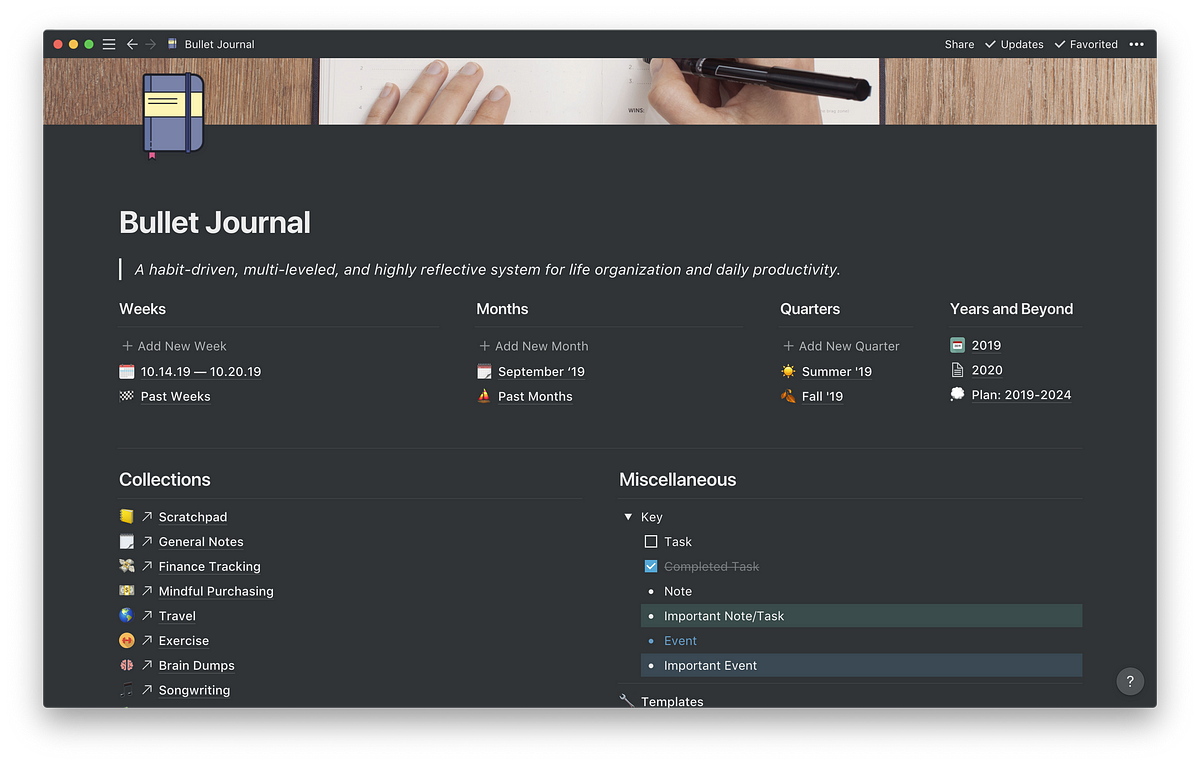
This is the page where it all begins. Leveraging Notion’s flexibility, I built out this page precisely to my needs but generally following the Bullet Journal framework. Everything from the template buttons (e.g. “+ Add New Week”) to the arrangement of columns is customizable.
The top row is what I like to call the “interval cascade”. It’s where I split out my life into a number of time durations, each designated its own column: weeks, months, quarters, years and beyond. Doing so allows me to use the longer intervals — months and longer — to plan things from a long-term perspective, then later “cascade” those plans into actionable items at the shortest interval — weeks.
For example, when a new week is about to start, I’ll hit the custom-built [+ Add New Week] button, which generates a new page pre-filled with a template that I designed.
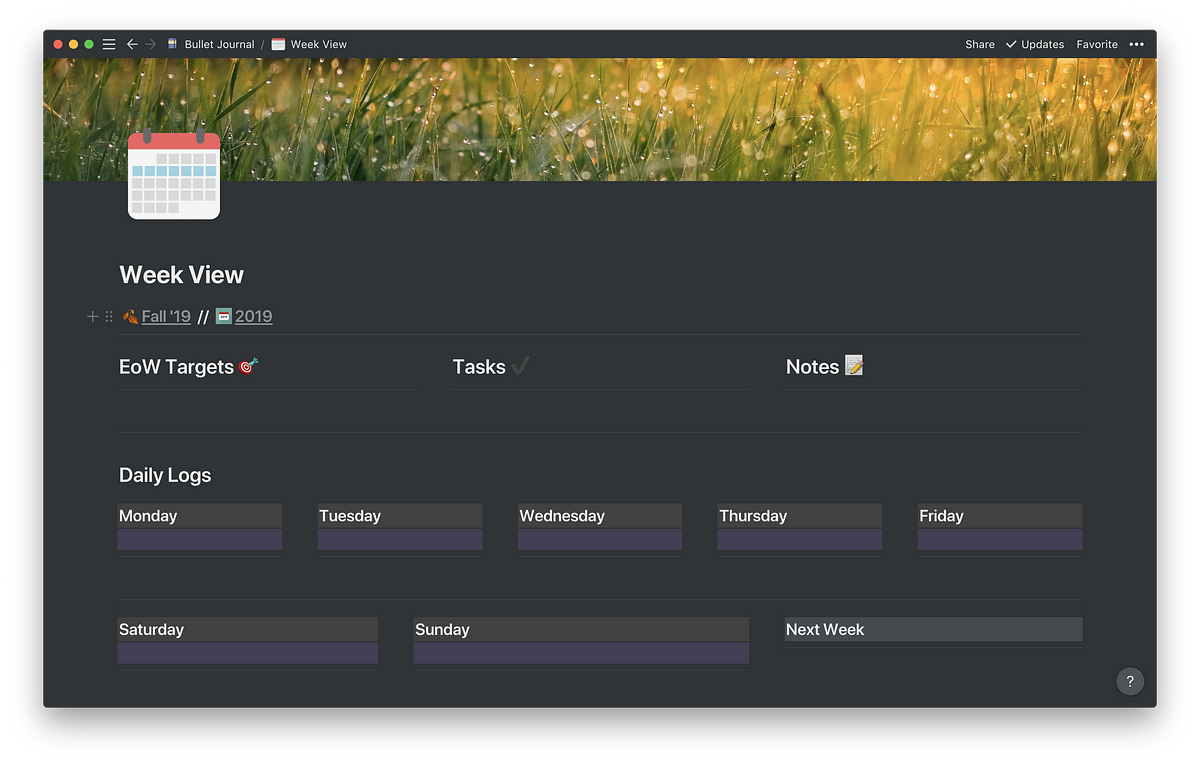
I can then click into the linked “Fall ‘19” page or even my “2019” page to peek at what I hoped to achieve during that longer interval. Converting those long-term goals into actionable items for the week, I fill out the “End of Week Targets”, “Tasks”, and whatever plans I’m currently aware of for each day of the week. Then throughout the week, I’ll use this page as my centralized repository for everything: notes, tasks, events, etc. Partway through the week, it might look something like this.
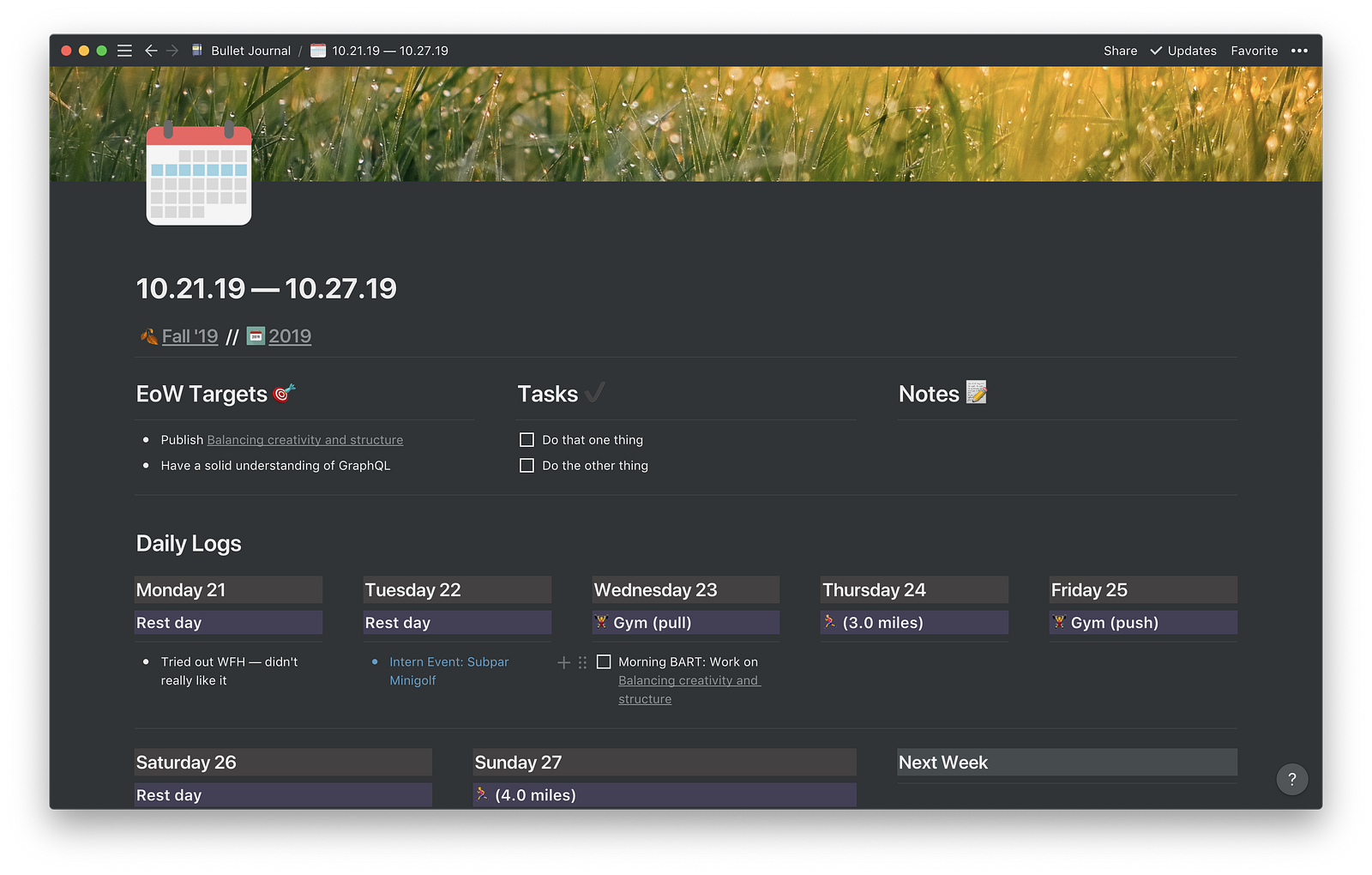
At the end of the week, I’ll drag the week’s page into the “Past Weeks” database, add a few reflective thoughts, and call it a week.

With this weekly log system + a plethora of other collections set up (e.g. for tracking books I read, how I’m spending my money, and even songs I’m learning on guitar), I entered into a bit of a honeymoon phase with Notion. I boiled down virtually everything in my life into some sort of system or process that I could fit into my interval cascade. These systems helped me power through my final undergrad online course, get my summer internship project scoped and completed, and even manage all the logistics of moving from Mountain House to Pleasanton. On top of that, I excitedly showed Notion, along with an enthusiastic demo of my setup, to anyone who seemed even remotely interested. Offering up my bullet journal template, I even got my team’s product manager at Clever to start using it!
But as honeymoon phases generally do, this one too was doomed to end.
After joyously using my Notion setup for over 3 months, I started to encounter problems with my Notion usage patterns that made me much less enthused about opening up my daily logs every evening and setting up my weekly page every Sunday night. It took me a few weeks of easing off the intensity with which I used Notion to start to understand why this was happening.
When I started my fall internship at Stripe, I was disappointed to learn that I wouldn’t be allowed to use Notion to record anything work-related. So much for an all-in-one workspace. My best alternative was to try to mimic the essential components of my “interval cascade” system in an app I was allowed to use, Dropbox Paper. Although it’s one of the best apps at what it does, Paper isn’t by any means an all-in-one-workspace and still falls far short of Notion in customizability and flexibility.
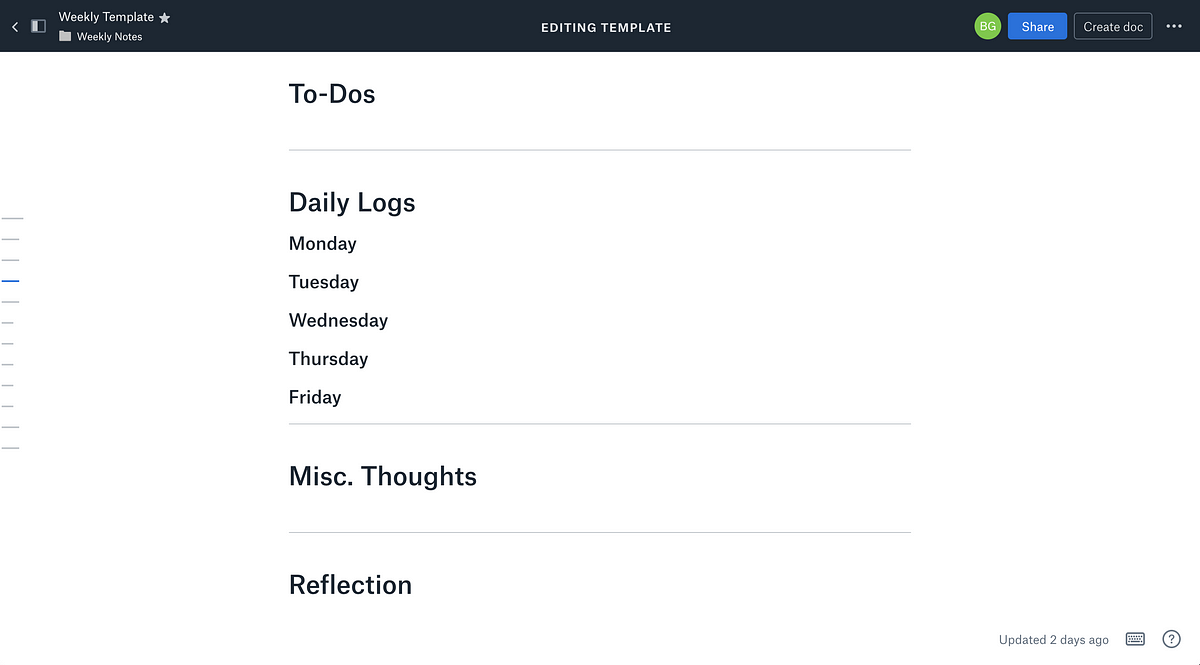
With all my work-related content going into Dropbox Paper, my Notion usage drastically dropped. At that point, the main things I was focusing on outside of work were reading, writing, and playing guitar.
Desperate to keep Notion in my life, I continued to use it for those things. However, since I approached all three of these activities as casual hobbies, the structure of my interval cascade system ended up having the opposite effect from what I intended. Rather than helping me “get things done”, it turned the hobbies that I was passionate about into a sort of job that I developed a quiet distaste toward.
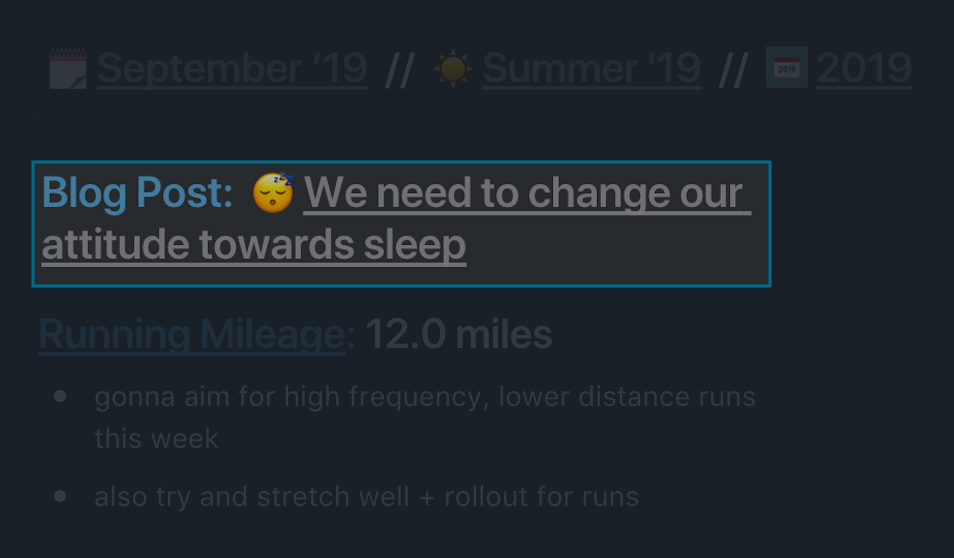
For example, after finishing reading “Why We Sleep” by Matthew Walker, I was excited to write a post to share my thoughts about it. I made a page in my Notion where I would collect my thoughts and write the post, then started linking to it at the top of my weekly log and in my daily logs as a to-do item. Slowly, my excitement about the post faded and was replaced with guilty apathy about not getting around to writing. Weeks went by as a vicious cycle of negative emotion formed. Every night that I’d go to bed unable to check off that I worked on the post, I’d feel worse, questioning whether I really even wanted to write it. The following day, that confusion and guilt would manifest in a further hampered desire to write.
Similarly, I’ve been working on writing a song but found that as soon as I started making to-do items for it, I lost both the creative spark and the intrinsic desire to see it through.
One of my key takeaways from this experience is that structure is a powerful tool but must be wielded carefully when it comes to creative endeavors.
I also learned that it’s crucial to clearly separate — at the very least in my own mind — my usage of Notion as a centralized repository for my thoughts versus as a productivity tool. While well-scoped projects like an online course or an internship fit both use cases, it’s an entirely different story for creative endeavors that require ample time and opportunity to explore ideas. I still believe that my Notion system is an excellent home for creative ideas to come rest after periods of exploration. It just shouldn’t be used to apply time constraints and structure where it isn’t truly useful.
Moving forward, I plan to use Notion as a way to document my posts and songs (among many other things) but leave the motivational/productivity aspects to my intrinsic passion towards writing and making music. In just a few days of trying this out, I’ve already seen how obviously beneficial this change is. When writing a new song is motivated by a to-do list item, I feel a pressure to come up with the right chords and lyrics. When it’s motivated by passion, I take my time, exploring melodies and words that may not always sound quite right but every so often turn out to be exactly what I’m looking for.
After all, what is creativity if not the freedom to fail?
How do you balance creativity and structure? I’d love to start a conversation about this! Leave your thoughts in the comments below or wherever else I shared this post.

